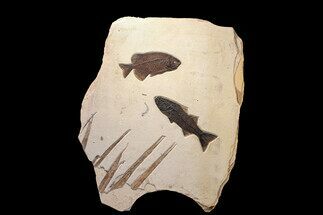The Ancient Herring
What Were Knightas?
The Knightia was an Eocene era fish from what is now the Green River Formation in Wyoming, USA. Knightias are most closely related to the common day Herring has an abundance of fossils. Large amounts of these fossils can be found in just a square yard of the fossiliferous rock they were fossilized in, which is known as Limestone.
| An artist's reconstruction of what a Knightia may have looked like |
Predators and Prey
Knightias were very important in the food chain, usually being eaten by different animals such as birds, snakes, and other large fish. Knightias usually ate arthropods, which were like small crustaceans, algae, and sometimes baby fish if they could fit one in their mouth.
 |
| A Knightia with a smaller fish in its mouth |
Anatomy
Knightias belong to the same family as sardines and herrings. They had rows of dorsal and ventral scutes that ran from the back of the head to the medial fins. Knightias had heavy scales and small teeth. The size of Knightias depended on the species: Knightia Eocaena were the longest, growing up to 10 inches, though most weren't much larger than about 6 inches. Another species, Knightia Alta were smaller but wider, with most of their fossils usually being between 2 inches and 4 inches.
Environment
Green River Wyoming wasn't always a dry place. In the Eocene era (which was about 34 million years ago) Green River was exactly what the name implied. There was a large river spanning from western Colorado, eastern Utah, and southwestern Wyoming in the United States. This area was once a warm climate, where you would find plants like cat-tails, sycamores, palms, and other plants that are located in North America. There were large inland lakes around the region, wherein the bottom of these lakes that different plants and animals were fossilized. Said lakes and rivers later dried up due to local climate change, and many plants and animals went extinct.
 |
| Two Green River fish with a part of a fossilized Palm leaf |
If I got anything wrong, please feel free to leave a comment and I will do my best to correct it!


Comments
Post a Comment